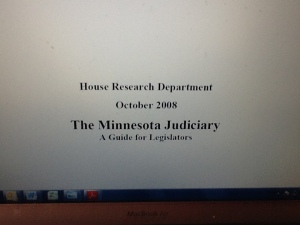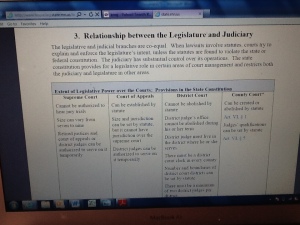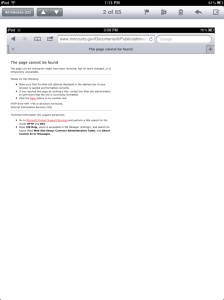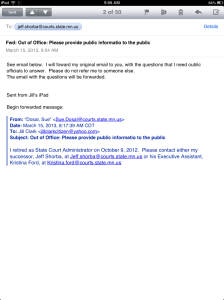In 2008 I filed a Petition with the Minnesota Supreme Court, along with a Voter. The Petition challenged whether Lorie S. Gildea’s was qualified to run for election to Minnesota Seat #4, and drew the conclusion that she was not.
Jill Clark_20130317_175648 (Part 1 of 2008 Petition)
Jill Clark_20130317_175748 (Part 2 of 2008 Petition)
We also pointed out the statewide concerted effort to prevent elections by judges agreeing (and then acting on that agreement) to resign before the end of their 6-year terms were over, with the understanding that the Governor would appoint a judge to take their place.
We pointed out that judges take an oath, to the public, to serve for 6 years. Although I did not elaborate the point at that time, I think it was understood, and I’ll say it now: Judges violate their oath of office when they claim they are going to serve a 6-year term, and then agree behind the scenes to do the opposite – to work in tandem with others to ensure the seat does not go up for election so that the People can select the new judge.
I very pointedly said in 2008 in the Supreme Court chambers, to the substitute Panel, that an agreement to violate the constitution violates the constitution.
I recall vividly discussion with now retired Judge Willis (sitting as substitute Justice), him incredulously asking whether we were suggesting that someone temporaily sit in the Seat #4 (or other seat emptied by resignation or disability) until the next election, and I said yes. I cannot recall what he said, but his reaction seemed to me to be that that would not be plausible.
Here’s the kicker.
Just this weekend, I reviewed a House Research Department (of the Minnesota Legislature) summary of The Minnesota Judiciary – A Guide for Legislators. It was published October 2008. The same year we challenged the ballot. And before the general election.

That document says, in describing the relationship between the legislature and the judiciary, that retired justices and judges of the court of appeals can be assigned to serve on the Supreme Court temporarily. See the page with that commentary, below (see lower-left-hand box).

So, not only was is possible, House Research put it in writing. In 2008.
Why, when I said it, was the reaction incredulity? It’s clearly possible. Judge Willis, himself, was sitting in a temporary justice position for that case. There is no reason that vacancies cannot be staffed with temporaily (to get the work done), still preverving the public’s right to select policy-making judges by election.
There was a lot of discussion during the 2008 oral argument about how the ballots would have to be reprinted if the Petition were granted. I could not believe this. The People of the State of Minnesota, denied their right to vote, because the court did not want the Secretary of State to have to pay to reprint the ballots? I mean, is the court neutral, or not? Why would the frankly measly amount it would cost to reprint the ballots, trumpt the citizens’ right to vote? That analysis, in and of itself, showed how far the courts have gone astray.
The courts were to be the watchdog of government. Instead, the courts got in bed with the executive branch, and became its rubber stamp, became its protector.
What about us?
What about the People?
Who is going to protect us?

The Panel “deliberated” (if you can call is that) for less than an hour, I heard. The result was, predictably, the People lose, the entrenched system of appointing judges in violation of the constitution – prevailed.
In 2010, we brought the challenge again, in a somewhat different form. That time, we focused on the Chief Justice position, and how it had not been run for 10 years.
Jill Clark_20130317_180908 (2010 Petition)
I had hopes that that Panel would do the right thing. I was disappointed when the Decision came out, signed by Justice Page (this, I thought to myself, was contrived so that the one Justice selected by election in the past decade, would have signed the document – I guess I did not think at the time to authenticate the signature), essentially whitewashing decades of unconstitutional conduct, and unconstitutional agreements to violate the constitution. I mean, if you can’t go to the Court to enforce the constitution – where can you go?
I want to be a bit more clear what I mean when I say “whitewash” the conduct and agreements. I believe that Decision had the goal of making it ok to do what the state judges and governors had been doing for years: conspiring to violate the constitution. So although the Minnesota Supreme Court says it applies the constitution, it did not do it when it came to its own.
Look, it’s not like I hid the ball. I was forthright when I communicated with the Minnesota Supreme Court. But, for reasons that are unclear to me, that Court thinks it can blatantly ignore motions, arguments, objections, and other legal filings. And here’s the thing: the only reason they got away with it for so many years, is the code of silence in my business.
And here’s the other thing, the thing about the code of silence, the reason there is so much intimidation, threats, subtle communication that you will LOSE YOUR LICENSE IF YOU TALK, it’s this one very powerful thing: if one person breaks the code of silence it is broken.
I have broken the code of silence.
There is no way to unbreak it.
Stay tuned for Part 2.










